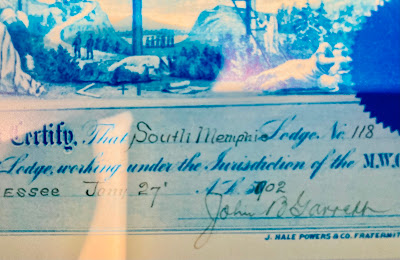 |
| Hurd Hatfield in The Picture of Dorian Gray, MGM, 1945. |
Second in a series recapping my recent trip to New Orleans.
I fell asleep the night before with the television on and awoke June 5 to Albert Lewin’s The Picture of Dorian Gray from 1945. After breakfast at the Clover Grill (how do they make the eggs like that?!) and while hurrying to get ready for the day of museum hopping, the TV was still on. You see a certain theorem on the chalkboard. The “Non ignoravi mortalem esse” translates, according to some Google hits, to something like “I have not ignored to be mortal,” which could make for a snappy answer to Memento Mori, if you’re an Al Jaffe fan with a better command of Latin.
It was a great day. At 400 Esplanade Avenue, you get two for one: downstairs is the Old U.S. Mint; upstairs, the Jazz Museum. If you ever collected U.S. coins and gathered a Morgan dollar, maybe there is an O on its reverse. That initial means the U.S. Mint at New Orleans struck that coin, as it had in the manufacture of hundreds of millions of dollars in gold and silver coinage between 1838-61, and 1879-1909.
 |
| I’ll have to remember to share this with Civil War Lodge of Research: These scraps of fabric are believed to be remnants of the U.S. flag once flown above the U.S. Mint in New Orleans. Early in the Civil War, Commodore David Farragut sent Marines into the city to seize the Mint, for obvious reasons. Mr. William Mumford, with a few accomplices, allegedly managed to steal the flag, and Mumford reportedly wore the flag’s tatters on his jacket henceforth. U.S. Gen. Benjamin Butler had Mumford hanged in front of the Mint on June 7, 1862. An outraged Confederate President Jefferson Davis ordered Butler to be executed immediately if ever captured. |
Its museum is a small space, but if you or someone you love is a numismatist, it’s worth visiting.
Upstairs is the New Orleans Jazz Museum. During my research before the trip, I thought maybe a museum devoted to jazz and located in New Orleans would be something on a Smithsonian scale, but not quite. Still a must see, but I was hoping for deeper history than what is offered. There actually was a near absence of Louis Armstrong, which the museum explained is the result of its preparing for Satchmo’s birthday—today! August 4, according to his baptismal certificate—with a special exhibit. The Mint building is the site of Satchmo Summerfest this weekend, if you’re in the neighborhood.
I really thought there might be a Masonic clue somewhere in the exhibits, given how many jazz legends were Freemasons, but I missed it if there is.
In late afternoon, after a bite and a beer at one of the ubiquitous Willie’s Chicken Shacks, I roamed the French quarter and did find something Masonic—finally, after stalking the streets for more than forty-eight hours. A jewelry store on Royal Street had these rings in its window:
 |
| Typical Masonic supply company catalog fare. |
Satisfied somewhat, I took a seat on the steps of the courthouse on Royal, joining a few homeless men, and lit up an Aroma de Cuba Monarch—a fine Fuente product! Also in my research, I found smoking is prohibited just about everywhere, yet the stench of marijuana is ever-present, so I thought quality tobacco should be represented.
I’m rambling because my memory is failing. I thought this was the day I had visited the Museum of the Southern Jewish Experience, but that actually was June 6. Anyway, I arrived there late that morning and did find a few Masonic items, plus several mentions of famous Masons.
 |
| All Masonic historians know how Masonic halls served their neighborhoods in many ways: as schools, post offices, civic meeting spaces, polling places, and even houses of worship. |
 |
| This is a facsimile of Bro. C.L. Schlom’s Masonic patent from 1902. He was at labor in South Memphis Lodge 118 in Tennessee. It remains of the rolls today, as Memphis 118, and will meet this Thursday at 7 p.m. for its August communication. |
And from the Famous Masons Department:
 |
| T.R. kicks ass. Typically, when we think of him vis-à-vis Russia, it’s about ending their war with Japan, but apparently he had earlier interactions. |
 |
| I’ll have to research Jonas Phillips because he was a fascinating figure in Revolutionary America. I believe the quotation above is borrowed from his petition to the Continental Congress of September 7, 1787, in which he lobbied to avoid religious requirements for Federal office holders. During the war, he would write correspondence in Yiddish, confounding the Redcoats who intercepted the letters. A few websites say he was a Freemason as of 1760. Maybe. I’ll check it out. |














































































